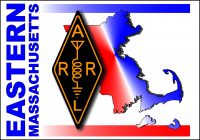Hello to all..
Cape Cod ARES will be hosting a mini-ARES Exercise on Saturday November 13th from 130-300 PM. Other districts within Eastern Massachusetts ARES that are interested in participating can monitor 3935 KHz 75 Meter HF or 146.955 MHz. In addition, the New England reflector Echolink conference *NEW-ENG* node: 9123/IRLP 9123 system will be monitored as well. Amateurs from other districts that participate in the mini-exercise are asked to give their 72-hour availability for ARESMAT to Cape Cod if this was an actual incident requring ARES support to their district. Further details and the Cape Cod ARES document for this mini-exercise as written by Cape Cod ARES DEC, WQ1O-Frank O’Laughlin are listed below:
http://ares.ema.arrl.org/local/CCARESdrill_41Doc11-12-10.pdf
Mini ARES exercise “Operation Hybrid storm” Saturday Nov 13 at 1:30pm- 300 pm
CCARES will hold its Mini-exercise #41 this Saturday at 1:30-3pm. This will be primarily an EOC type exercise. We will also have home stations participating to back up our primary stations. This is a follow up to the Earl activation in September. We will be starting our normal net on the RACES repeater at 146.955Mhz PL 88.5 as we normally would for an activation. Check-ins will be called for after the start of the net. At some point the repeater will likely fail requiring a move to the output of the repeater as standard RACES policy (146.955 Mhz simplex, NO shift or tone). Net control station (NCS) ARES HQ Hyannis will direct a move to one of our simplex frequencies after that time. The ARES backup EOC station WA1KCC will also be operational. This station will also have HF capability on 75m SSB on 3935khz and will be guarding that frequency for contacts. Since HF is a wider area system, all station having the capability may contact other stations as the MACC does NOT have HF capability. Winlink messaging protocol is a different animal. It is important that the primary stations be aware of important messages passed on winlink to avoid redundant confusion and key stations being left in the dark. When winlink messages are sent, the other key stations (NCS, MACC, other EOC stations) should be CCd on the message. This insures that all the stations have the same info.
Example:
Harwich EOC needs to make a request to the MACC. Harwich would also CC the message to NCS and the other EOC stations.
Station contact protocol:
In an actual operation, protocol would be for shelters to contact the local EOC for requests. Since we are not having the shelter layer active for this exercise, we start at the EOC level. EOCs would contact the MACC station (K1DYO). EOCs could also contact the ARES HQ station in Hyannis for any ARES related needs or info that has to go to NCS.
We will have the ARES southern sub-regional command station (WA1EMA Acushnet EOC) active for this operation as well. Normal protocol would be for the MACC station to communicate with the southern sub-regional command station. Other EOCs could contact southern command if the MACC was unavailable.
Home stations:
Home stations are the extended resource to the operation. They can be relay points, net control stations, and backup stations. They will check in just as the EOC stations do during the operation. They are free to use any mode necessary to accomplish the path ( provided the ultimate receiving station can communicate there.)
Messaging:
Messaging will include NTS type messages and tactical messages. Due to time constraints, stations should only send one or two messages per half hour time block. Most messages should not require a reply as this will also increase the time issue. Each EOC should designate someone to create/send the messages and receive messages.
Unannounced problems:
All stations should be prepared for an unexpected event and act quickly react.
73’ Frank WQ1O
Cape Cod and Islands ARES DEC

